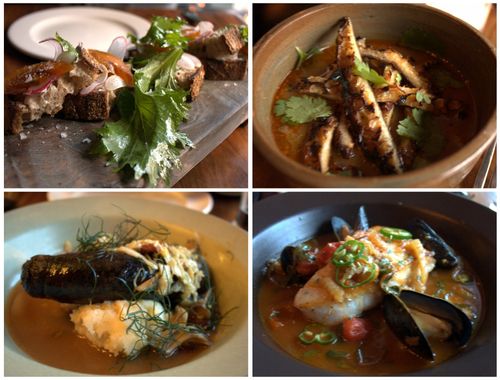 1/2 Even though school started this week and we’ve slogged through torrential downpours, September is still summer—and therefore, a perfectly good time of year to experience nature’s bounty of tomatoes, corn and melon (bah, more about that later) This particular month wasn’t part of my original plan, though.
1/2 Even though school started this week and we’ve slogged through torrential downpours, September is still summer—and therefore, a perfectly good time of year to experience nature’s bounty of tomatoes, corn and melon (bah, more about that later) This particular month wasn’t part of my original plan, though.
There was no impetus for a trip to Blue Hill at Stone Barns beyond a July panic that I should be eating summer foods somewhere that takes such things seriously, i.e. not my home. My only two previous visits were in the dead of winter, so cold you had to run from the parking lot the entrance and missed the whole point of escaping NYC, and before they implemented the freeform, tasting menu-only approach. Eh, and I was violently sick and ruined my own meal last time. (Through no fault of the restaurant; I was getting over a two-week-long flu and didn’t want to cancel my reservation. That was a mistake.) It was time for a re-do. Except that the soonest weekend opening available was for Sunday, August 28 at 9:30pm. I took it anyway.
And when Hurricane Irene was predicted I thought I was being a genius by searching Open Table for cancellations. There were plenty. 5pm on a Saturday? No problem. Except that Saturday morning the restaurant closed. Wisely, it turned out, because even days later on a Thursday for our rescheduled dinner, the hour drive ended up taking three (!) because of the Saw Mill Parkway being closed, flooding and other unforeseen detours. (On the way back we were re-thwarted and discovered the Brooklyn Battery Tunnel was closed, then the Brooklyn Bridge entrance, too. 9/11 prep or normal construction, I don’t know. By the time I set foot in the apartment it was 3am.)
Being a weeknight (and having just eaten at Town House over Labor Day—two decadent parades of food just seemed a bit much for one week) we opted for the smallest number of dishes, five, which would presumably be plenty satisfying—and the right number for one bottle of wine, a 2004 Eitelsbacher Karthäuserhofberg Spätlese, preceded by a gin cocktail with purple basil and a glass of cava.
Bubbly always signals special occasion (and really, the restaurant’s three-and-half-year-old, new-to-me style is the epitome of special occasion dining—there were lots of candles sheltered in glass domes, brought to tables to be blown out) and we were asked if we were celebrating anything. We were not, though I would’ve been well within my rights to mention our twelve-year dating anniversary that occurred three days before. I’m not attention-starved.
No matter, the meal that unfolded was anniversary-worthy and then some. No restrictions, no allergies, no food off-limits. (Not 100% true—there’s only one food in the entire world that I don’t like but wouldn’t necessarily bring it up under the context of “Do you eat offal or mind raw seafood?” because it’s so benign to most that I can’t bear bringing it up out of fear of looking like a dilettante. Ok, I hate melon, yes even watermelon, and cantaloupe in particular. The offending fruit showed up three times during this meal! Because it’s still summer, duh. And yes, I ate it without complaint because I don’t tolerate food babies and no one should put up with crap from me either.)
Let’s just say that five courses was merely a guideline. The amount of food was highly unexpected, edible shock and awe, which I’m not complaining about. I just had not anticipated a four-hour dinner and closing down the restaurant. You have to be mentally and physically prepared for such decadence! And I’m still sad about leaving behind a good portion of the final savory course: pork in a zillion forms—especially after hearing about how cute and fat the piglets were getting.
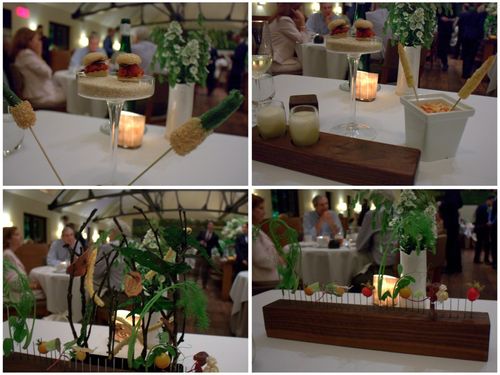
The meal was kicked off with a single lettuce leaf (a similar one-leaf approach occurred at Town House the previous weekend). Then you’re consumed by which naked piece of produce to snatch from the row of metal spikes first, though soon your attention is diverted by a jungle of dried kale, tempura beans and thin rounds of pancetta.
The mini burgers are a diminutive hallmark; beets in the past, this time with tomato and bacon. And a really sweet bun, which I liked. Keeping up the make-the-diner-feel-like-a-giant theme, finger-sized zucchini and “corn dogs,” battered, fried little stalks served with a bitter corn and beer shot, added to the tableau.
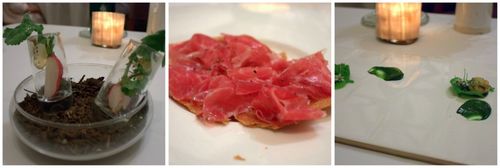
Natural sweetness enhanced by salt was the theme. I never get people, always food people, who cite radish and butter sandwiches as a revelatory dish. Use fresh enough butter and barely bitter radishes and a good dose of salt…and ok, it makes more sense.
A coca, that would be a Barcelonan thin, crackly near-pizza (I only know this because twice I went to La Vinya del Senyor looking for a version with red peppers and sugar and both times they did not have it) comes blanketed with cured ham.
Fish balls with phytoplankton mayonnaise. What’s phytoplankton, you ask? Microscopic organisms that form the basis aquatic life. Dan Barber encountered its culinary applications at Aponiente in Cádiz. Will powdered, reconstituted algae be the next shredded beef tongue?
My subconscious must be stronger than realized because I have no photographic evidence of the melon balls with cracked pepper and watermelon juice course. If forced to choose, I will concede that watermelon is the more tolerable variety.
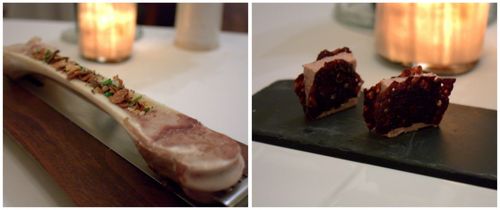
The garden showcase segues into a meaty period with a veal marrow bone (love the tailor-made contraption) topped with breadcrumbs and foie gras sandwiched between lacy chocolate wafers.
It’s hard to say where the amuses end and the courses begin.
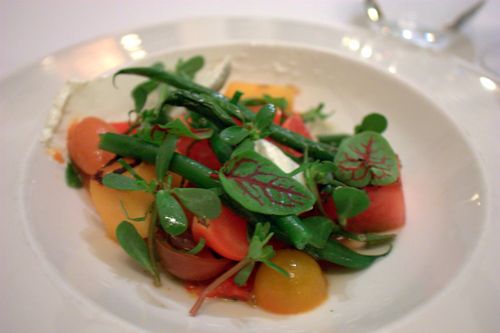
More melon! I will also concede that grilling the bad-sweet pink cubes adds a complexity that paired well with good-sweet tomatoes and a touch of goat cheese.
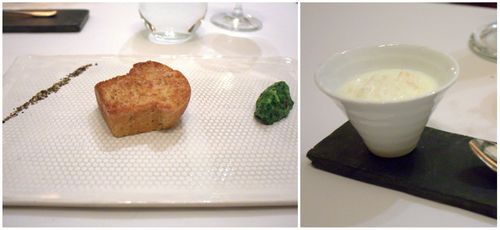
Ricotta is stirred into solidity tableside and is meant to be eaten with a thick piece of brioche and a mound of greens (spinach? chard?). I’m pretty sure tiny raisins were tucked into the sautéed vegetable.
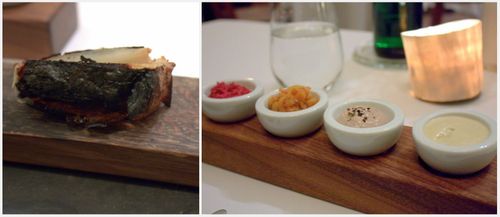
We wondered if the wild flames visible through a darkened window were intentional (after the flooding and hurricanes, who knew?) Yes, and our onions cooked in “biochar” were one of the things in the fire pit. The soft, caramelized guts could be eaten with a hazelnut-leek spread, chicken liver, peaches or beets. The latter may have worked the best, but I loved the variety.
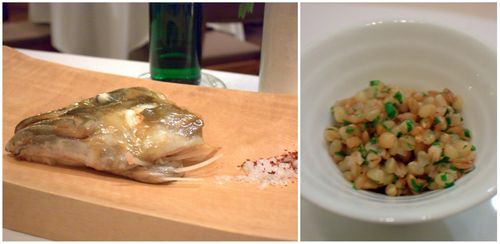
Hmm…when the chopsticks appeared I wondered what was coming. I didn’t notice anything particularly Asian on the tables nearby. Fish head? Indeed! I was not expecting a nice gelatinous piece of cod simply presented with a pile of salt and chile flakes for flavor and to be eaten with a small vessel of grains. (I could not tell you the myriad varieties, though our informative server definitely would’ve found out, if asked.)
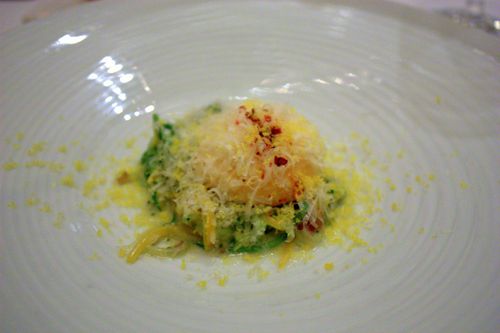
This is no mere egg yolk sitting atop zucchini shreds. An unborn egg aged to the texture of parmesan is treated similarly to the hard Italian cheese and is grated on top. Egg two-ways. Thankfully, the fish head was as wild as they got and balut wasn’t incorporated for a three-way.
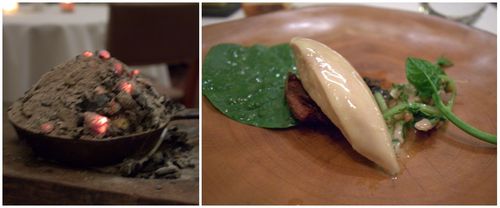
Salt-baked chicken in a charred crust. I have to admit I was feeling a bit fatigued by this point, so I didn’t ask about the chicken that James insisted was seasoned with pork. Was it? The pristine flesh has clearly been glazed with something.The fried potato dish beneath had to have been. The flavor of the meat was so intense and savory that if only derived from the poultry itself I will begin ponying up for the farm-raised chickens I’m normally too cheap to indulge in.
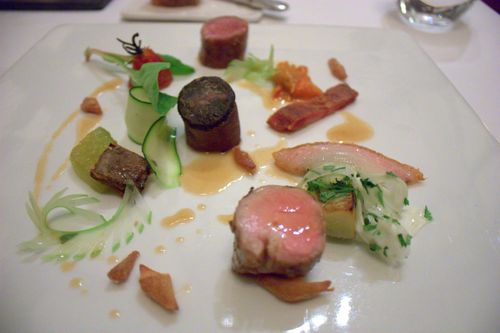
Waah, pork…rich, fatty pork. Why did it have to come at the end? I was only able to handle a few bites from this sampler of bacon, blood sausage, ears, loin and even little chicharrones. (I’d just stocked up on pork skins at gas stations all over North Carolina so my pork tolerance is high.)
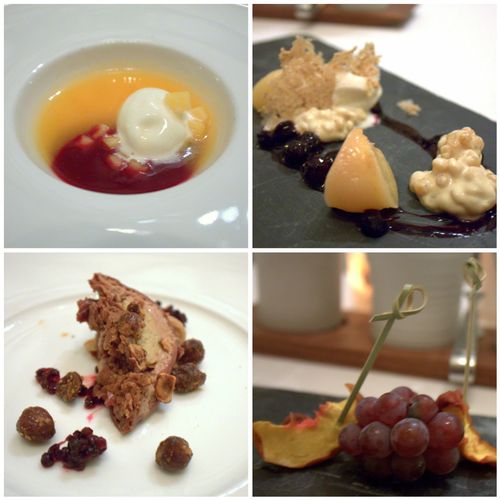
Nothing like a cantaloupe palate cleanser, cut with concord grapes (phew) to transition to the sweeter side. This was followed by a semolina pudding with blueberries (and plums?), a chocolate hazelnut mousse with elderberries and an ender nearly as simple as the initial lettuce leaf: dried white peaches and a cluster of grapes.
The restaurant has really elevated its style—the ethos is produce-forward, but more accessible and soothing than some of the forage-heavy roots-leaves-and-twigs school that’s in vogue—since my long-ago last visit. It feels very American. I wonder what influence Peru will have on the cuisine’s future. We were told that “Dan was in the city” before being offered a peek into the kitchen. What they didn’t say was that the city was Lima.
Blue Hill at Stone Barns * 630 Bedford Rd., Pocantico Hills, NY


 Follow
Follow

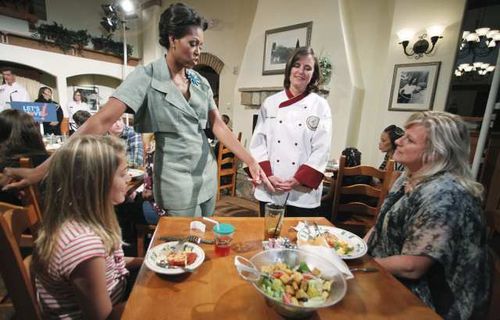
 1/2 Even though school started this week and we’ve slogged through torrential downpours, September is still summer—and therefore, a perfectly good time of year to experience nature’s bounty of tomatoes, corn and melon (bah, more about that later) This particular month wasn’t part of my original plan, though.
1/2 Even though school started this week and we’ve slogged through torrential downpours, September is still summer—and therefore, a perfectly good time of year to experience nature’s bounty of tomatoes, corn and melon (bah, more about that later) This particular month wasn’t part of my original plan, though.










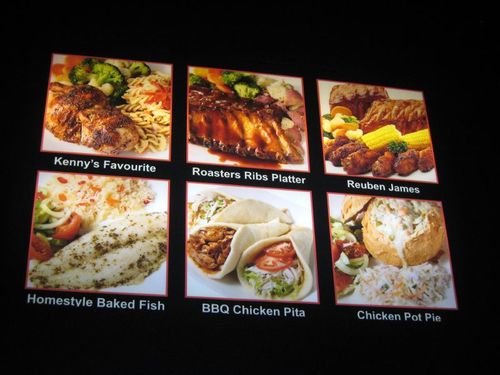

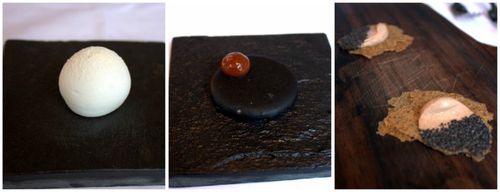

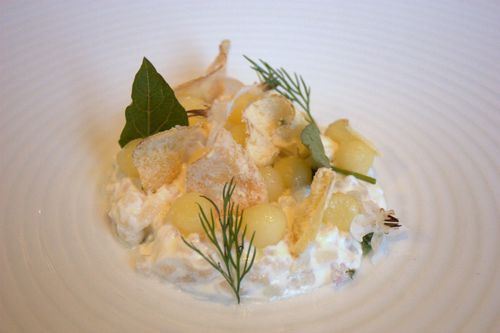
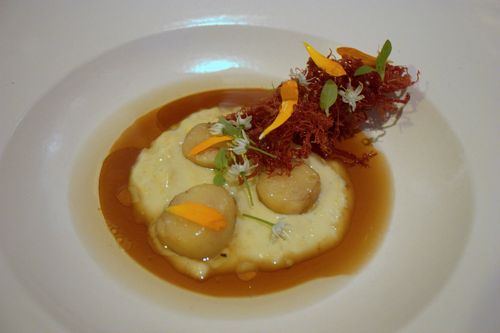
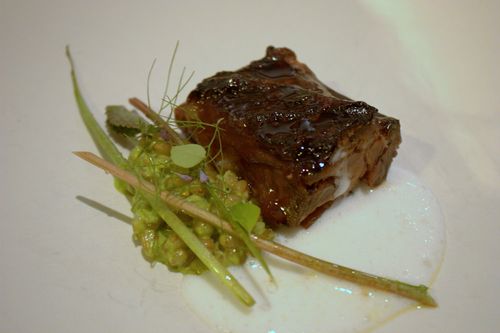
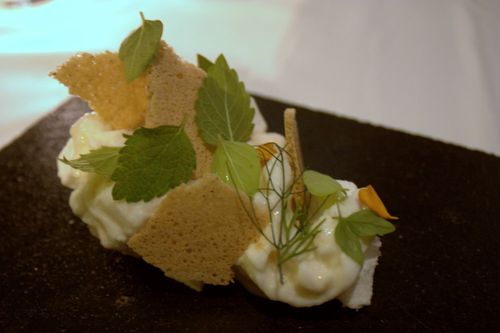
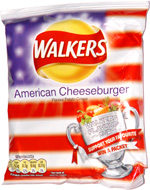
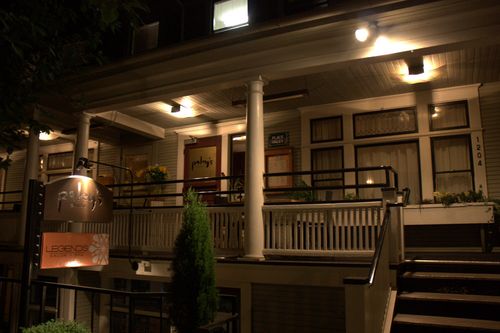
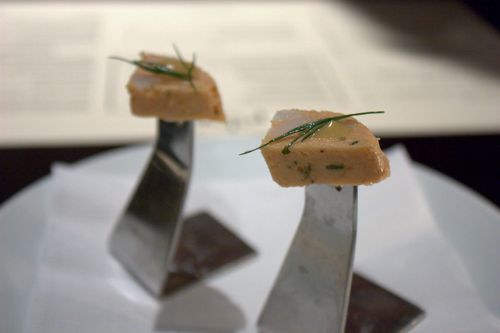
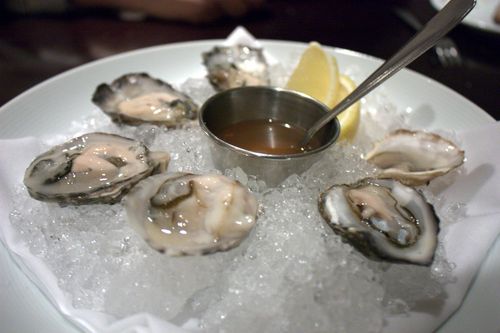
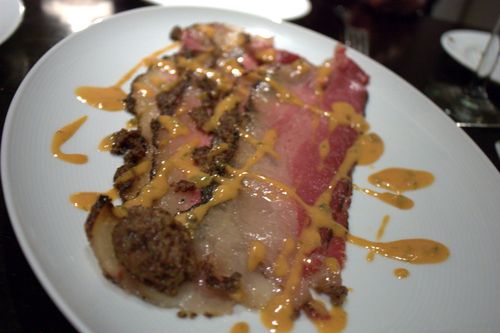
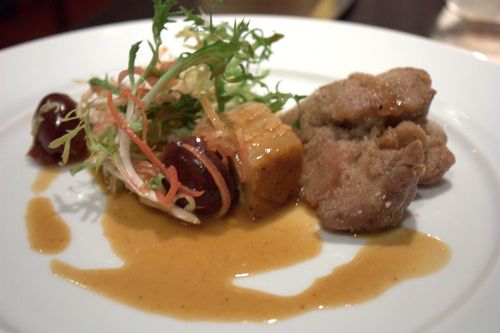
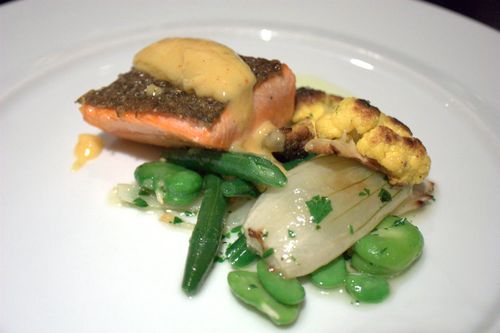
 I managed to take part in Bon Appetit’s so-called
I managed to take part in Bon Appetit’s so-called 